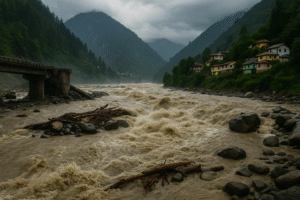Welcome to the second blog of our series – “Fungi & Earth: Allies in Carbon Restoration“
As we continue our journey through “Eco-Fungi: Earth’s Climate Fix,” our next stop delves into an often-overlooked aspect of carbon sequestration: soil inorganic carbon (SIC) regeneration. While organic carbon capture gets much of the spotlight, the role of fungi in the world of inorganic carbon is equally vital for climate mitigation. This chapter shines a light on the groundbreaking role fungi play not just in the realm of organic matter but in the vast, intricate world of minerals and soil chemistry.
Fungi, the silent architects beneath our feet, engage in processes that transform the land and, in doing so, hold keys to mitigating climate impacts on a global scale. Join us as we explore how these microscopic organisms are pioneering the regeneration of soil inorganic carbon and contributing to climate mitigation efforts in ways we are only beginning to understand.
The Untold Story of Soil Inorganic Carbon
Soil inorganic carbon, often overshadowed by its organic counterpart, plays a vital role in the global carbon cycle and climate regulation. Unlike organic carbon, which comes from living or once-living organisms, inorganic carbon is found in the form of minerals and dissolved carbonates in soil. This type of carbon not only comprises a significant portion of the Earth’s terrestrial carbon pool but also influences soil health and its capacity to support life.

- Fungi and Mineral Interactions
Fungi interact with soil minerals in remarkable ways, facilitating the formation and stabilization of inorganic carbon. Through their biochemical activities, fungi can weather rock minerals, releasing inorganic carbon compounds into the soil. This process not only contributes to soil formation and fertility but also captures carbon in forms that are less likely to return to the atmosphere as CO2. It’s a subtle yet powerful mechanism that adds a new layer to our understanding of carbon sequestration and the dynamic processes within the soil.
- A Hidden Carbon Sink
The role of fungi in stabilizing soil inorganic carbon highlights the soil as a hidden carbon sink, capable of storing vast amounts of carbon in stable, inorganic forms. This function of soil contributes to reducing greenhouse gas concentrations in the atmosphere, making it a critical factor in climate change mitigation strategies. The interaction between fungi and soil minerals, thus, represents an untold story of hope and potential in our ongoing efforts to address climate change.
Fungi: Architects of Carbon Minerals
Fungi operate as master architects in the natural world, particularly when it comes to the formation of carbon minerals within the soil. Their role extends beyond mere interaction with organic carbon; fungi also influence the soil’s inorganic carbon content, a less talked about but equally critical aspect of carbon sequestration. Through their activities, fungi contribute to the process known as mineral weathering, where rocks and minerals break down to release nutrients and, importantly, capture carbon in stable mineral forms.

- The Process of Mineral Weathering
Mineral weathering is a natural process enhanced by fungi through their production of organic acids. These acids help break down rock minerals, releasing calcium, magnesium, and other elements that react with CO2, eventually forming stable carbonate minerals. This process not only provides essential nutrients for the ecosystem but also traps atmospheric carbon in a form that can remain locked away for thousands of years, contributing to long-term carbon storage and climate mitigation.
- Fungi and the Carbon Cycle
In their role as architects of carbon minerals, fungi are an integral part of the carbon cycle. They act at the intersection of biological and geological processes, turning atmospheric carbon dioxide into stable, inorganic forms within the soil. This unique ability showcases the importance of fungal biodiversity for the health of our planet, underscoring the need to protect and maintain natural habitats where these processes occur.
Enhancing Soil Health and Carbon Sequestration
Fungi are not only vital for their ability to create carbon minerals but also for their overarching impact on soil health and carbon sequestration. Healthy soil is the foundation of productive ecosystems, and fungi are key contributors to this health, affecting both the physical structure and chemical composition of the soil.

- Improving Soil Structure
The mycelium, a network of fungal threads, acts as a natural binder, holding soil particles together and improving its structure. This enhanced soil structure increases porosity, making it easier for roots to grow and for water to infiltrate and be retained within the soil. Such conditions are ideal for plant growth and the microhabitats of countless microorganisms, contributing to a vibrant, living soil.
- Boosting Carbon Sequestration
By improving soil health, fungi boost the soil’s capacity to sequester carbon. Healthy soils rich in organic matter can store vast amounts of carbon, drawing it down from the atmosphere and reducing the impact of greenhouse gases on global warming. Fungi contribute to this process not just by breaking down organic material and incorporating it into the soil but also by enhancing the soil’s physical properties, which in turn supports more plant life and leads to greater carbon sequestration.
In essence, fungi serve as both architects and builders in the natural world’s efforts to combat climate change. Their role in forming carbon minerals, improving soil health, and enhancing carbon sequestration illustrates the complex and crucial ways these organisms support the Earth’s ecosystems and help mitigate the effects of climate change.
Fungi and Sustainable Land Management
In our journey to understand the roles of fungi in climate change mitigation, we discover their significant contribution to sustainable land management. Sustainable land management refers to practices that manage land use to meet present and future needs while ensuring the long-term potential of land resources. Fungi, through their unique abilities, play a critical role in making land management practices more sustainable and environmentally friendly.

- The Soil Protectors
Fungi are like the guardians of the soil. They help maintain soil health by decomposing organic matter and recycling nutrients, which is crucial for plant growth and soil fertility. But their role doesn’t stop there. By forming symbiotic relationships with plants, fungi improve water retention and nutrient uptake, making plants more resilient to stress and reducing the need for chemical fertilizers. This natural fertilization process is essential for maintaining the balance and health of ecosystems.
- Enhancing Soil Structure
One of the less visible but equally important roles of fungi in sustainable land management is their ability to enhance soil structure. The mycelial networks of fungi bind soil particles together, creating stable soil aggregates. This improved soil structure enhances water infiltration and reduces erosion, making land more resilient to extreme weather conditions such as droughts and floods. By preventing soil degradation, fungi play a pivotal role in ensuring the sustainability of our land resources for future generations.
The Global Impact of Fungi on Climate Mitigation
Fungi’s influence extends beyond local ecosystems to have a global impact on climate mitigation. Their ability to sequester carbon and improve soil health plays a crucial part in the global efforts to combat climate change. By locking carbon away in the soil, fungi reduce the concentration of CO2 in the atmosphere, addressing one of the root causes of global warming.

- A Natural Solution to a Global Problem
The role of fungi in climate mitigation is a prime example of how nature can offer solutions to some of our most pressing global challenges. Their work in carbon sequestration and soil improvement highlights the interconnectedness of all life forms and the importance of biodiversity in maintaining a healthy planet. As we seek ways to mitigate climate change, the role of fungi reminds us of the potential that lies in harnessing natural processes for global benefit.
- Fungi and the Future of Climate Action
Looking towards the future, the global impact of fungi on climate mitigation underscores the need for conservation and sustainable management of fungal habitats. Protecting forests, grasslands, and other ecosystems where fungi thrive is essential for preserving their climate-mitigating abilities. Furthermore, integrating fungal ecology into climate change models and land management practices can enhance our efforts to reduce atmospheric CO2 levels and combat global warming.
Fungi’s contributions to sustainable land management and climate mitigation exemplify the untapped potential of natural systems in addressing environmental issues. As we continue to explore and understand the roles of fungi, we unlock new pathways for sustainable development and a healthier planet.

Author’s Note
Exploring the role of fungi in soil inorganic carbon regeneration highlights the complex interplay between organisms and the Earth’s carbon cycle. Through this blog, we hope to illuminate the critical functions fungi perform beneath our feet, contributing to soil health and climate change mitigation. As we uncover these natural processes, we’re reminded of the importance of preserving biodiversity and supporting ecosystems in our fight against global warming.
G.C., Ecosociosphere contributor.
References and Further Reading
- “Soil Science and Management” by Edward Plaster – Offers a comprehensive look at soil health, including the roles of microorganisms in soil processes.
- “Mycorrhizal Planet: How Symbiotic Fungi Work with Roots to Support Plant Health and Build Soil Fertility” by Michael Phillips – Explores the symbiotic relationships between fungi and plants and their impact on soil health.
- “Dirt to Soil: One Family’s Journey into Regenerative Agriculture” by Gabe Brown – Chronicles the transformation of conventional farming practices into regenerative methods that support soil health and biodiversity.
Join us in our next installment as we delve into the incredible world of biochar and its environmental benefits, further exploring the multifaceted role of fungi in our quest for sustainable solutions to climate change.





Comments
Your article helped me a lot, is there any more related content? Thanks!
Can you be more specific about the content of your article? After reading it, I still have some doubts. Hope you can help me.
Your article helped me a lot, is there any more related content? Thanks!
Can you be more specific about the content of your article? After reading it, I still have some doubts. Hope you can help me.